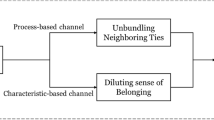Abstract
To understand the influence of social capital (the size of local supportive networks and generalized trust) in facilitating success across societies varying in residential mobility, the data of 16,253 participants from 29 provinces/municipalities in China were examined. For the role of local supportive networks, the results showed that people with more social capital were better off (in terms of current income, social mobility from 5 years ago and social mobility from teenage) than those with less social capital in more residentially mobile societies whereas social capital was a weaker predictor of success in less residentially mobile societies. For generalized trust, the results showed that the positive role of generalized trust in promoting success was less sensitive to the influence of societal residential mobility. These findings suggest that expansion of local supportive networks may be more important in facilitating success in more residentially mobile societies than in less residentially mobile societies.


Similar content being viewed by others
Notes
Data used in this paper is from the China Labor-force Dynamics Survey (CLDS) by the Center for Social Science Survey at Sun Yat-sen University in Guangzhou, China. The opinions are the author's alone. Please refer to http://css.sysu.edu.cn for more information about the CLDS.
The results with robust standardized errors were used due to the violation of the assumption of homogeneity of level-1 variance (Garson 2012).
References
Baumeister, R. F., & Leary, M. R. (1995). The need to belong: Desire for interpersonal attachments as a fundamental human motivation. Psychological Bulletin, 117, 497–529. doi:10.1037/0033-2909.117.3.497.
Bourdieu, P. (1986). The forms of capital. In J. G. Richardson (Ed.), Handbook of theory and research for the sociology of education (pp. 241–258). New York: Greenwood.
Brissett, I., Scheier, M. F., & Carver, C. S. (2002). The role of optimism in social network development, coping, and psychological adjustment during a life transition. Journal of Personality and Social Psychology, 82, 102–111. doi:10.1037//0022-3514.82.1.102.
Center for Social Science Survey. (2012). China Labor-force Dynamics Survey (CLDS). Retrieved from http://css.sysu.edu.cn.
Coleman, J. S. (1988). Social capital in the creation of human capital. American Journal of Sociology, 94, S95–S120.
Cornwell, B. (2009). Good health and the bridging of structural holes. Social Networks, 31, 92–103.
Delhey, J., & Newton, K. (2003). Who trusts? The origins of social trust in seven societies. European Societies, 5, 93–137. doi:10.1080/1461669032000072256.
Fatima, M., & Shafique, M. (2015). Health and academic performance of university students: Direct and mediating effect of social capital. Pakistan Journal of Commerce and Social Sciences, 9, 357–379.
Garson, D. G. (2012). Hierarchical linear modeling: guide and applications. Thousand Oaks, CA: Sage.
Gillath, O., & Keefer, L. A. (2016). Generalizing disposability: Residential mobility and the willingness to dissolve social ties. Personal Relationships. doi:10.1111/pere.12119.
Granovetter, M. (1973). The strength of weak ties. The American Journal of Sociology, 78, 1360–1380.
Li, L. M. W., Hamamura, T., & Adams, G. (2015). Relational mobility increases social (but not other) risk propensity. Journal of Behavoiral Decision Making. doi:10.1002/bdm.1894.
Lun, J., Roth, D., Oishi, S., & Kesebir, S. (2012). Residential mobility, social support concerns, and friendship strategy. Social Psychological and Personality Science, 4, 332–339. doi:10.1177/1948550612453345.
Manski, C. F. (2000). Economic analysis of social interactions. Journal of Economic Perspectives, 14, 115–136.
Oishi, S. (2010). The psychology of residential mobility: Implications for the self, social relationships, and well-being. Psychological Science, 5, 5–21. doi:10.1177/1745691609356781.
Oishi, S., & Kesebir, S. (2012). Optimal social-networking strategy is a function of socioeconomic conditions. Psychological Science, 23, 1542–1548. doi:10.1177/0956797612446708.
Oishi, S., Kesebir, S., Miao, F. F., Talhelm, T., Endo, Y., Uchida, Y., et al. (2013). Residential mobility increases motivation to expand social network: But why? Journal of Experimental Social Psychology, 49, 217–223. doi:10.1016/j.jesp.2012.10.008.
Oishi, S., & Schimmack, U. (2010). Residential mobility, well-being, and mortality. Journal of Personality and Social Psychology, 98, 980–994. doi:10.1037/a0019389.
Paxton, P. (1999). Is social capital declining in the United States? A multiple indicator assessment. American Journal of Sociology, 105, 88–127. doi:10.1086/210268.
Putnam, R. D. (2000). Bowling alone: The collapse and revival of American community. New York: Simon and Schuster.
Raudenbush, S. W., Bryk, A. S., & Congdon, R. (2004). HLM 6 for Windows [Computer software]. Lincolnwood, IL: Scientific Software International.
Reis, H. T., Collins, W. A., & Berscheid, E. (2000). The relationship context of human behavior and development. Psychological Bulletin, 126, 844–872. doi:10.1037/0033-2909.126.6.844.
Sandefur, R. L., & Laumann, E. O. (1998). A paradigm for social capital. Relationality and Society, 10, 481–501. doi:10.1177/104346398010004005.
Schug, J., Yuki, M., & Maddux, W. (2010). Relational mobility explains between- and within-culture differences in self-disclosure to close friends. Psychological Science, 21, 1471–1478. doi:10.1177/0956797610382786.
Szabolcs, K. (2011). Solitary minds and social capital: Latent inhibition, general intellectual functions and social network size predict creative achievements. Psychology of Aesthetics, Creativity, and the Arts, 5, 215–221. doi:10.1037/a0022000.
United Nations Population Division. (2009). International migration report 2009: A global assessment. New York, NY: United Nations.
Wang, X., & Kanungo, R. N. (2004). Nationality, social network and psychological well-being: Expatriates in China. International Journal of Human Resource Management, 15, 775–793.
Yamaguchi, A. (2013). Impact of social capital on the psychological well-being of adolescents. International Journal of Psychological Studies, 5, 100–190.
Funding Support
The present research was funded by the Fundamental Research Funds for the Central Universities Grant (#16wkpy27) awarded to L. M. W. Li.
Author information
Authors and Affiliations
Corresponding author
Rights and permissions
About this article
Cite this article
Li, L.M.W. Social Class, Social Capital and Residential Mobility in China. Soc Indic Res 132, 1117–1129 (2017). https://doi.org/10.1007/s11205-016-1339-9
Accepted:
Published:
Issue Date:
DOI: https://doi.org/10.1007/s11205-016-1339-9




